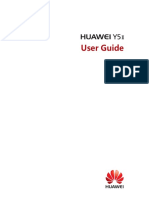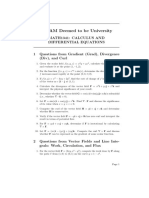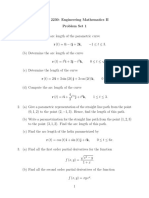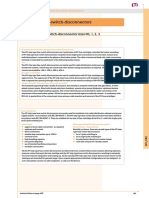Assignment 7(Vector field)
Uploaded by
conquerxclashAssignment 7(Vector field)
Uploaded by
conquerxclashVector field
1. Evaluate the line integral:
(a)Find the line integral of f (x, y, z) = 3x2 + (2xz − y) + z over the straight line segment from
(0,0,0) to (2,1,3).
(b) Integrate f (x, y, z) = (x+y+z)/(x2 +y 2 +z 2 ) over the path r(t) = tî+tĵ+tk̂, 0 < a ≤ t ≤ b.
(c) Integrate
√ √ f (x, y) = x2 − y over the curve C : x2 + y 2 = 4 in the first quadrant from (0,2)
to ( 2, 2).
2. (a) Find the gradient field of the function f (x, y, z) = ez − ln(x2 + y 2 ).
(b) Give a formula F = M (x, y)î + N (x, y)ĵ for the vector field in the plane that has the
properties that F = 0 at (0,0) and that at any other point (a,b), F is tangent √ to the circle
2 2 2 2
x + y = a + b and points in the clockwise direction with magnitude |F| = a2 + b2 .
3. Evaluate C F.dr for the vector field F = y î − x ĵ counter-clock wise along the unit circle
R
x2 + y 2 = 1 from (1,0) to (0,1).
4. Find the circulation and flux of the field F = −y î + x ĵ around and across each of the
following curves:
(a) The circle r(t) = cos t î + sin(t)ĵ, 0 ≤ t ≤ 2π.
(b) The ellipse r(t) = cos t î + 4sin(t)ĵ, 0 ≤ t ≤ 2π.
5. Let F = −4xy î + 8y ĵ + 2k̂ be the velocity of a fluid flowing through a region in space. Find
the flow along the curve r(t) = t î + t2 ĵ + k̂, 0 ≤ t ≤ 2.
6. Which fields are conservatives, and which are not?
(a) F = y sin(z) î + x sin(z) ĵ + xy cos(z)k̂
(b) F = y î + (x + z) ĵ − y k̂
7. Find the potential function f for the field F.
(a) F = ey+2z ( î + x ĵ + 2xk̂).
(b) F = ex î + 3y ĵ + 4z k̂.
y z
(c) F = (ln x + sec2 (x + y)) î + (sec2 (x + y) + √ 2 2
) ĵ + √ 2 k̂.
y +z y + z2
8. Show that the differential form in the integrals are exact. Then evaluate the integrals.
Z (3,5,0)
(a) (yz dx + xz dy + xy dz)
(1,1,2)
Z (3,3,1)
(b) (2x dx − y 2 dy − 4/(1 + z 2 ) dz)
(0,0,0)
9. Find the work done by F = (x2 + y) î + (y 2 + x) ĵ + zez k̂ over the following paths from (1,0,0)
to (1,0,1):
(a) The line segment x = 1, y = 0, 0 ≤ z ≤ 1.
(b) The helix r(t) = cos(t) î + sin(t) ĵ + (t/2π)k̂, 0 ≤ t ≤ 2π
10. Verify Green’s Theorem for the field F = −x2 y î + xy 2 ĵ for the disk R : x2 + y 2 ≤ a2 and its
bounding circle C : r(t) = a cos(t) î + a sin(t) ĵ, 0 ≤ t ≤ 2π.
11. Find the outward flux of the field
F = (3xy − x/(1 + y 2 )) î + (ex + tan−1 y)x) ĵ
across the cardioid r = a(1 + cos(θ)), a > 0.
12. Evaluate the integral along the closed curve C : (x − 2)2 + (y − 3)2 = 4:
Z
(6y + x)dx + (y + 2x)dy
C
13. (a) Find the area of the surface x2 − 2y − 2z = 0 that lies above the triangle bounded by the
lines x = 2, y = 0, y = 3x in the xy-plane.
(b) Integrate g(x, y, z) = x + y + z over the portion of the plane 2x + 2y + z = 2 that lies in
the first octant.
14. Find the flux of the field F = 4x î + 4y ĵ + 2k̂ outward (away from z-axis) through the surface
cut from the bottom of the paraboloid z = x2 + y 2 by the plane z = 1
15. Using Stoke’s theorem find the circulation of the vector field F around the curve C in the
given direction:
(a) F = x2 î + 2x ĵ + z 2 k̂
C: The ellipse 4x2 + y 2 = 4 in the xy-plane, counterclockwise when viewed from above.
(b)F = x2 y 3 î + ĵ + z k̂
C: The intersection of the cylinder x2 + y 2 = 4 and the hemisphere x2 + y 2 + z 2 = 16, z ≥ 0,
counterclockwise when viewed from above.
16. Evaluate Z Z
∇ × (y î) · n dσ
S
where S is the hemisphere x2 + y 2 + z 2 = 1, z ≥ 0.
17. Use divergence theorem to calculate the outward flux of F across the boundary of the region
D:
(a) F = y î + xy ĵ − z k̂
D: The region inside the solid cylinder x2 +y 2 ≤ 4 between the plane z = 0 and the paraboloid
z = x2 + y 2 .
(b) F = (5x3 + 12xy 2 ) î + (y 3 + ey sin(z)) ĵ + (5z 3 + ey cos(z))k̂
D: The solid region between the spheres x2 + y 2 + z 2 = 1 and x2 + y 2 + z 2 = 2 .
You might also like
- Applied Math III (Math 2042), Worksheet IINo ratings yetApplied Math III (Math 2042), Worksheet II6 pages
- National Institute of Technology Calicut Department of Mathematics MA 1001D: Mathematics 1No ratings yetNational Institute of Technology Calicut Department of Mathematics MA 1001D: Mathematics 12 pages
- 62-215 Practice Questions From Chapter 16 Winter 2013No ratings yet62-215 Practice Questions From Chapter 16 Winter 20131 page
- Examination For Internal Students: University College LondonNo ratings yetExamination For Internal Students: University College London4 pages
- Analytic Geometry: Graphic Solutions Using Matlab LanguageFrom EverandAnalytic Geometry: Graphic Solutions Using Matlab LanguageNo ratings yet
- Download Complete (Ebook) Routledge Handbook of Sustainable and Resilient Infrastructure by Paolo Gardoni ISBN 9781138306875, 1138306878 PDF for All Chapters100% (10)Download Complete (Ebook) Routledge Handbook of Sustainable and Resilient Infrastructure by Paolo Gardoni ISBN 9781138306875, 1138306878 PDF for All Chapters67 pages
- Cambridge First (FCE) Reading Part 1: Answer All The Questions and Check Your Answers at The EndNo ratings yetCambridge First (FCE) Reading Part 1: Answer All The Questions and Check Your Answers at The End45 pages
- Syllabus: Survey Training Institute, H-8/2 IslamabadNo ratings yetSyllabus: Survey Training Institute, H-8/2 Islamabad7 pages
- NV Strip Type Fuse-Switch-Disconnector Sizes 00, 1, 2, 3No ratings yetNV Strip Type Fuse-Switch-Disconnector Sizes 00, 1, 2, 33 pages
- Accessories and Consumables Catalogue: Edition 2 - 2015No ratings yetAccessories and Consumables Catalogue: Edition 2 - 2015108 pages

























































































